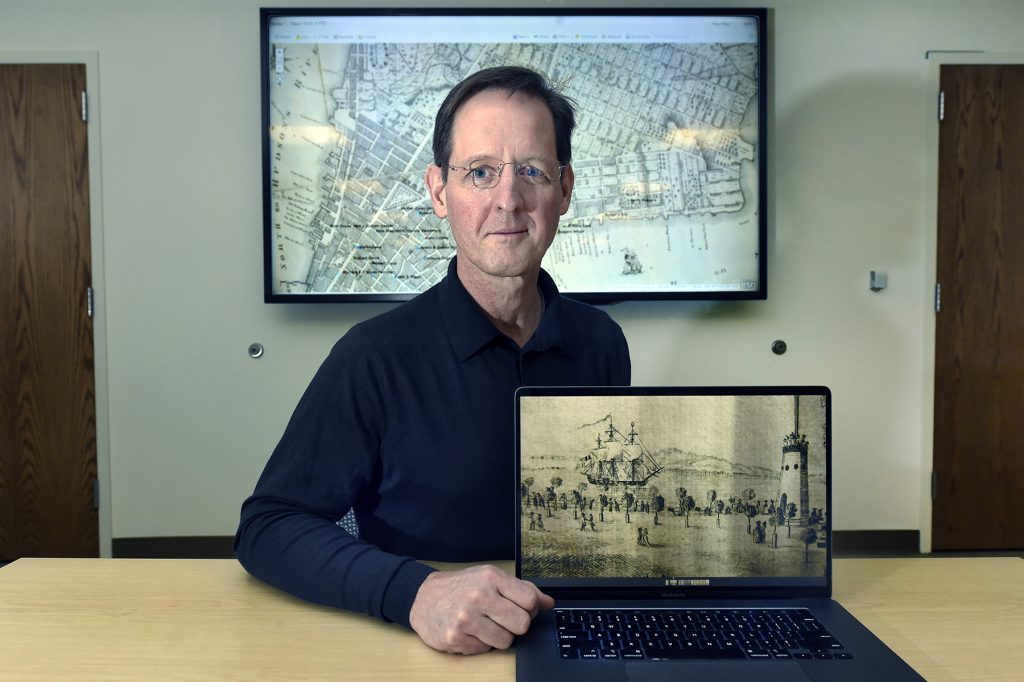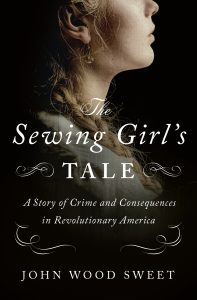
Editor’s note: This story was originally published in October 2022. John Sweet’s The Sewing Girl’s Tale was recently announced as a co-winner of this year’s Bancroft Prize. According to The New York Times , the prize “is one of the most prestigious honors in the field of American history.”
Bookmark This is a feature that highlights new books by College of Arts and Sciences faculty and alumni, published the first week of each month. This month’s featured book is The Sewing Girl’s Tale: A Story of Crime and Consequences in Revolutionary America (Henry Holt and Co.) by John Sweet.
Content warning: The following contains information about a crime of sexual violence that happened in the 18th century that is the focus of the book.
Q: Can you give us a brief synopsis of your book?
A: The Sewing Girl’s Tale is the story of a crime committed in the back room of a New York brothel on a moonless night in 1793 — the kind of crime that even the victim usually wanted to keep secret. Instead, 17-year-old seamstress Lanah Sawyer did what no one else in the city had done in half a century: She charged a gentleman with rape. The trial rocked the city and nearly cost Lanah her life.
And that was just the start.
Based on deep and extensive historical research, The Sewing Girl’s Tale is a searing account of the origins of modern rape culture — and a vivid exploration of the lives of ordinary Americans in the aftermath of the Revolution. It is a story of a young woman looking to make her way in a city full of possibility and danger; a story of working men fed up with being disparaged and dismissed by snobbish elites clinging to their privileges; and a story of early feminists making bold new arguments about human rights at a time when the only way most single women could earn a living wage was by working as a prostitute.
Q: How does this fit in with your research interests and passions?
A: I’m fascinated by the tumultuous world of early America — from the colonial period through the aftermath of the Revolution. Much of my work has been devoted to developing a more inclusive and expansive view of American history — to viewing our shared history not through the eyes of the so-called Founding Fathers but through the eyes of ordinary people. Usually, we see the aftermath of the American Revolution through the eyes of the so-called Founding Fathers. In this book, I wanted to shift perspective and explore how that momentous period looked to an ordinary New Yorker, a 17-year-old seamstress named Lanah Sawyer. To tell Lanah Sawyer’s story, I wanted to do more than just figure out what had happened. I also wanted readers to be able to visualize the world she lived in. And I wanted to explain the options she faced and the motivations that drove her and the other characters who shaped her story.
The result is a messier, pricklier history of life in New York during the early years of the new nation, but also, I think, one that is more vibrant and dramatic, and more representative of the experiences of ordinary Americans.
 Q: What was the original idea that made you think: “There’s a book here?”
Q: What was the original idea that made you think: “There’s a book here?”
A: The Sewing Girl’s Tale tells a story that, for a long time, I thought I understood. I first encountered the case when I was a graduate student in the late 1980s — shortly after Ms. Magazine coined the term “date rape.”
And that was pretty much how I saw it: as a particularly vivid and troubling example of the problem of acquaintance rape. Over the years, I used the extraordinary report of the trial (the first detailed account of a rape trial published in the United States) in my classes — to help undergraduates explore the historical origins of modern rape culture.
But then, about 10 years ago, a graduate student I was working with — Maren Wood — came across a brief notice in a newspaper from five years after the rape trial that called all my assumptions about the case into question. Could I really have been so wrong, I wondered? So I started to investigate, digging into the surviving evidence and scrounging around for clues. The more I learned, the more astonishing, puzzling and illuminating the story became.
Q: What surprised you when researching/writing this book?
A: I’ve spent my entire career studying and teaching early American history, but this project kept throwing me for a loop. I was surprised by a lot of what I learned about Lanah Sawyer’s background and her family. I was surprised by how big prostitution was in this period — and by the gap between how courtship worked in the novels and stories of the day and how it worked in real life. I was surprised by the audacity of the defense lawyers during the rape trial and their blatant efforts to rewrite the law. I was surprised that the jury’s verdict provoked such widespread outrage — that there were riots in the streets. And by the number of incisive, forceful feminists who raised their voices. I was surprised that Lanah Sawyer actually did get meaningful legal recourse. I was surprised that a man like the perpetrator, Henry Bedlow, ended up in debtors’ prison. I was surprised by the scurrilous tactics his attorney, Alexander Hamilton, used to get him out. And, call me naive, but I was surprised every time I caught someone lying.
In the end, though, what was most surprising was that the more I learned about the dynamics of sexual assault today, the more modern and heartbreaking Lanah Sawyer’s story seemed. So much of this story could have taken place on a college campus today. We live in a startling, similar culture of sexual predation and impunity. Part of what makes Lanah Sawyer’s story so inspiring and gut-wrenching is its immediacy. To me that always feels uncanny even though —as I argue — that’s because so much of our modern gender system and legal culture was actually coming into being during this period, during the legal struggles at the heart of this book.
Q: Where’s your go-to writing spot, and how do you deal with writer’s block?
A: Back in graduate school, a friend told me that I could get my dissertation written in three hours a day. I found that very liberating. And it worked — pretty much. For a historian, writing is only part of the job — there is also a lot of reading and research and, of course, teaching. Like many people, I find writing the biggest emotional challenge. And I always feel better when I get a solid block of writing in each day — even if I’m just going in circles or throwing pasta at the wall.
I like to write first thing in the morning. For a long time, my favorite writing spot was Caffè Driade. If the weather was good, I’d sit outside on the patio; in winter, I’d squat at a tiny table inside. I loved the gorgeous lattes — and the escape from Wi-Fi and household chores! But the pandemic put the kibosh on that ritual. So, now, as soon as I can get the kids out the door to school, I pour my own coffee and head to my home office. It’s a small space, but it has big windows and great views. Still, I miss the liveliness of a cafe.
John Sweet is a professor of history in UNC’s College of Arts and Sciences. Learn more about the book at https://www.johnwoodsweet.com/. Listen to an Institute for the Arts and Humanities’ podcast with Sweet about the book, and read a review in The New York Times.
Nominate a book we should feature by emailing college-news@unc.edu. Find previous “Bookmark This” features by searching the term on our website, and add some books to your reading list by checking out our College magazine books page.
